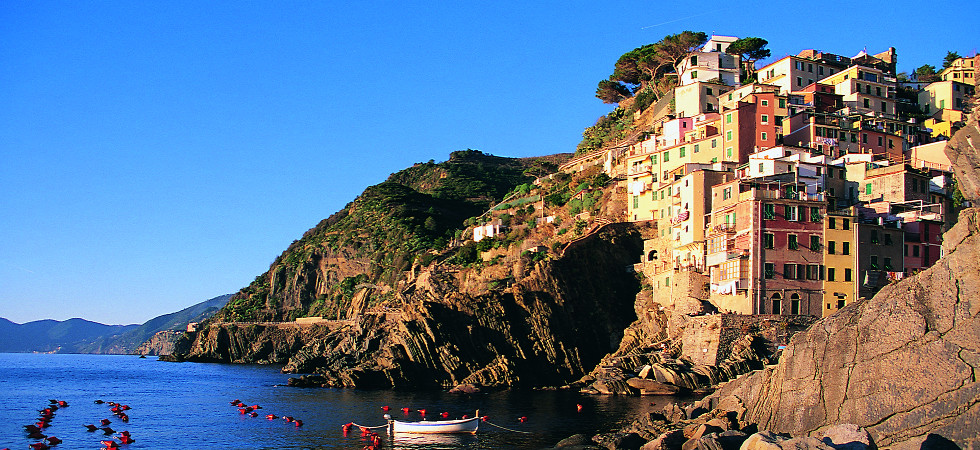For those seeking that elusive peaceful spot in which to unwind, a tranquil and charming place to escape the constant demands of life in the fast lane, the Cinque Terre, located on the glorious Italian Riviera on a rugged section of the Liguria region is the ideal destination.
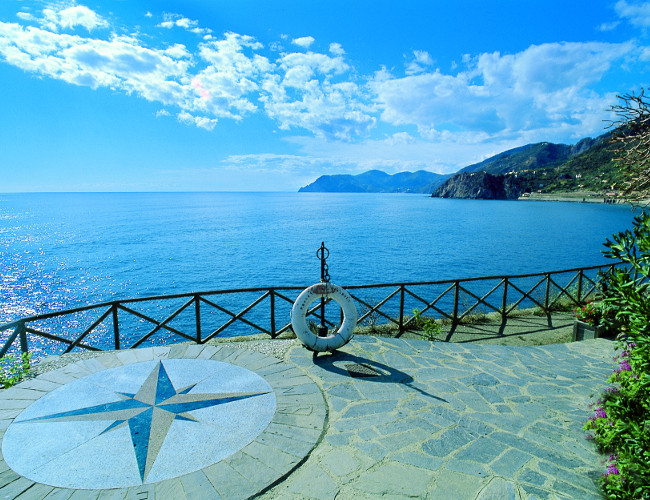
La Cinque Terre, (which translates to five lands), dates back to the 11th century and consists of the five small Medieval villages of Monterosso al Mare, Manarola, Vernazza, Riomaggiore and Corniglia. Recognised as a ‘cultural landscape’ and awarded UNESCO World Heritage Site status in 1997, the Cinque Terre is a protected national park, linked by a series of meandering paths and the railway line, which was built in the 1870’s, cuts through a series of coastal tunnels. The area, known for its lush vineyards, citrus orchards and olive groves, is partly inaccessible by car and the best way to travel is by train from Rome, Genoa or Pisa or drive to La Spezia and then board the local train. An area of outstanding natural beauty, the Cinque Terre attracts hardy souls keen to hike the seven mile coastal trail linking all five villages. Water babes seeking solitude will find a surprising number of coves and bays dotted along the coastline and a leisurely dip in the glittering waters of the Mediterranean is sure to soothe those aching limbs at the end of a day’s arduous explorations.
Riomaggiore is the Cinque Terre’s most famous village due to its prolific production of Sciacchetrà, a delicious sweet dessert wine with aromas of honey and white blossoms and hints of citrus. It is said that the origins of Riomaggiore date back to the 8th century when the inhabitants of La Spezia’s Vara valley relocated to the coastal regions in order to escape marauding pirates and to benefit from the milder climate in their cultivation of grapevines and olive trees. The town reflects its history and is characterized with typical pastel coloured houses perched along a vertical axe and a number of very steep staircases are the only means by which to move around the interior. Riomaggiore is also the main embarkation point for the Cinque Terre hike and the first leg along the Via dell ‘Amore (the ‘love walk’), which leads to Manarola, is easy, due to the width of the path, and as it is level with the seaside promenade the panoramic ocean views are simply breath-taking.
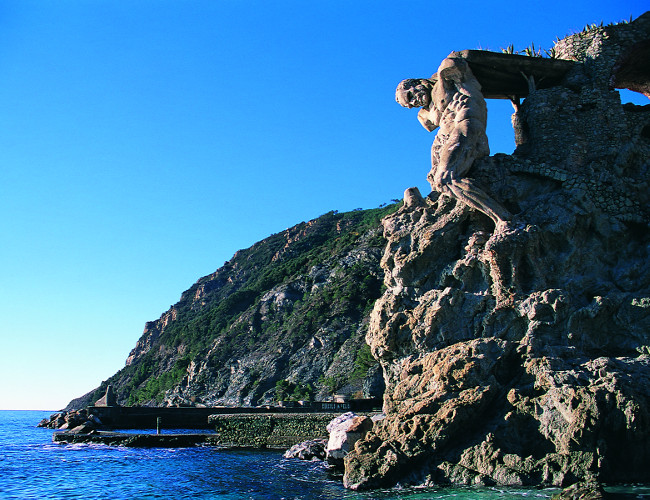
Manarola, the oldest village in the Cinque Terre is the ideal place to stay. Located only 200 metres from the town’s main square and a short distance from the train station, the Hotel Porto Roca holds a prominent position with the beautiful bay spread out below. The property offers a selection of suites measuring 44 sqm with double balconies furnished with comfortable sun loungers, and of course that is the perfect place for an afternoon snooze. Contemporary furnishings include walk-in wardrobes, spacious bathrooms featuring Jacuzzis, double washbasins and all the amenities expected including WI-FI. The hotel also features a sea view infinity pool (open from June to September), which faces a small secluded bay and it’s the ideal spot for an early morning dip prior to embarking on the next leg of a hike.
The hiking trail from Manarola to Corniglia is not for the faint hearted and although it takes only an hour the trail crosses a promontory and dips down to the original railway line. Those who embark on this path will be richly rewarded with a view of the little houses perched on a ridge around 100 metres above sea level and surrounded by tumbling vineyards. To reach the town, visitors must negotiate the Lardarina; which consists of 33 flights of steps. Local attractions include St Peter’s church, which was built in 1334 and reflects the dramatic intensity of the Baroque style with Gothic and Ligurian elements. The 14th century façade is adorned with a white marble rose window and the interior features a christening font dating back to the 12th century.
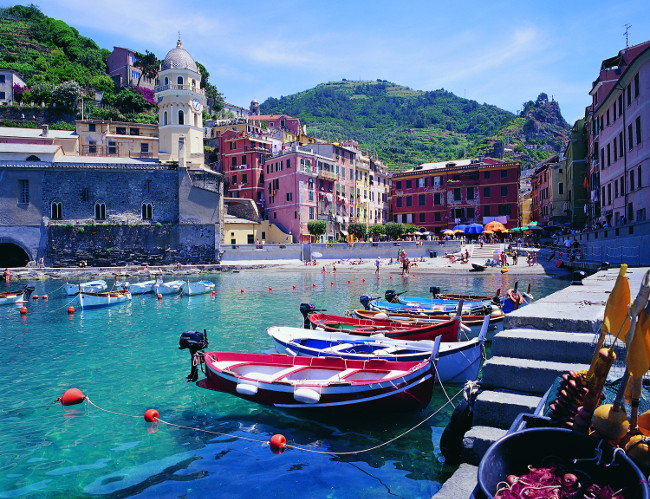
The three mile hike from Corniglia to Vernazza and the section from there to Monterosso offers the most challenging paths with uneven terrain, meandering and narrow walk ways through vineyards and lemon and olive groves and of course the most spectacular views which demand attention at strategic vantage points along the way.
During the Middle Ages, Vernazza, which has a natural harbour, prospered greatly as a fishing and trading centre and records show that the town was fortified prior to 1080 and was thought to be a departure point for naval forces defending the area from buccaneers. Local places of interest include the Doria Castle, the oldest surviving fortification in the Cinque Terre. Built in the 15th century, it was used as a lookout tower to alert the village to foreign invaders. The Church of St Margherita d’Antiochia, which dates back to 1318, is located on Piazza Marconi, the main square. The small church, which was built in the Gothic-Ligurian style, features an octagonal belfry soaring 40 metres into the sky. It is said that a casket containing the remains of St Margaret was washed ashore nearby and the church was built in her honour.
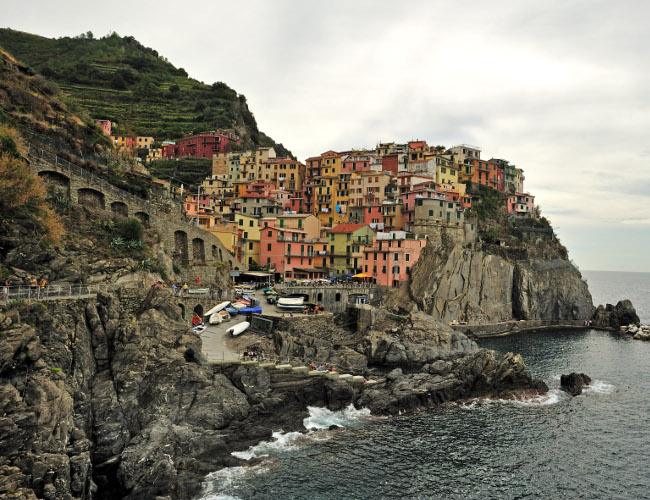
Monterosso al Mare, is only a 90 minute hike away, located in the province of La Spezia and it covers an area of 11.25 kilometres. Considered by locals to be the unofficial capital of the Cinque Terre, it is divided into two areas; the old town and the new town of Fegina. Local attractions include the Cappuccini Abbey and the Church of Saint Francesco, which occupy a site on the hill of Cristoforo. The church, which dates back to 1632, features an aisle encircled by wooden altars and treasures include one of Anthony van Dyck’s masterpieces, ‘the crucifixion’, painted around 1630. Fegina also features the largest sandy beach in the Cinque Terre and the pedestrian tunnel which links the old and new towns can become very crowded in the summer months. Near to Fegina’s beach, lies another local attraction, which garners much interest; the Monterosso Giant is an impressive sculpture of Neptune, looking out over the ocean. The imposing statue, sculpted by Arrigo Minerbi in 1910, stands 14 metres high on a promontory and although it was severely damaged during WWII and subsequently by the unrelenting elements, it is clearly a masterpiece.
Should the sea air awaken your appetite, an outstanding dining experience awaits at L’Ancora della Tortuga located on Salita Cappuccini. Dine ‘al fresco’ and sample some local specialities such as focaccia bread, served with anchovies and olives and order a glass of Sciacchetrà. And as you admire the ocean view make a toast to ‘la bella vista’ of La Cinque Terre and reflect on the words of one of Italy’s most famous sons; Leonardo da Vinci; who once said ‘Simplicity is the ultimate sophistication’.
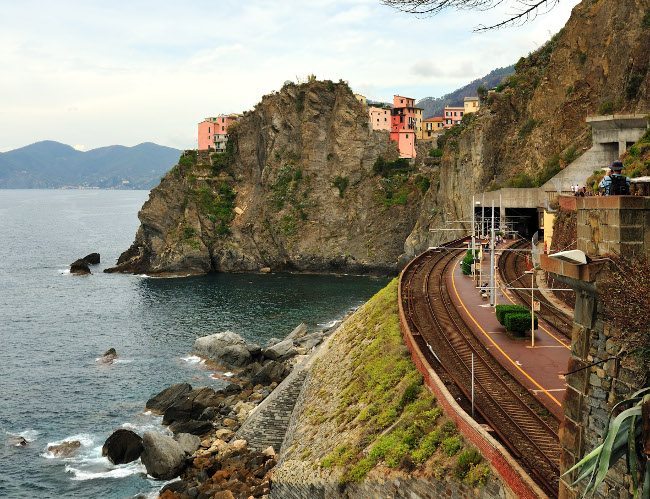
Top Tip: For access to the hiking paths purchase a Cinque Terre Pass prior to arrival. Local bus and train travel is also included. For more information visit parconazionale5terre.it/Ecinque-terre-card.php
Top Tip: During high season (Easter and mid-June to mid-September) the majority of hotels accept bookings on a half board basis only.












